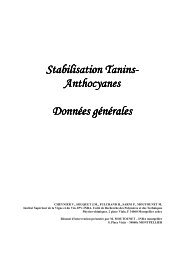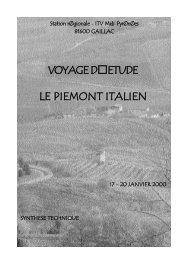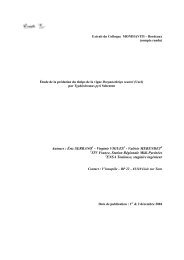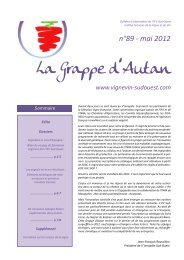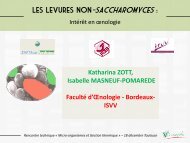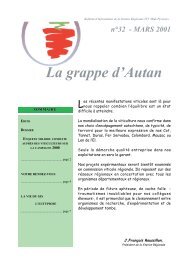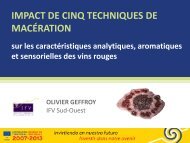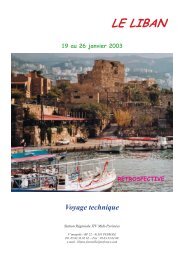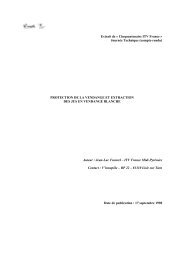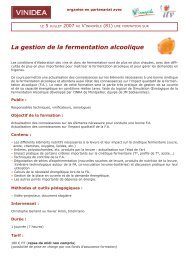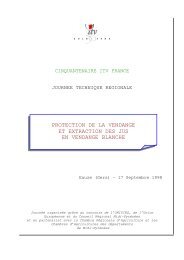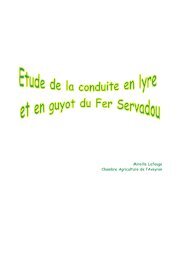Bioconversion de l'acide p-coumarique par Brettanomyces ...
Bioconversion de l'acide p-coumarique par Brettanomyces ...
Bioconversion de l'acide p-coumarique par Brettanomyces ...
Create successful ePaper yourself
Turn your PDF publications into a flip-book with our unique Google optimized e-Paper software.
Author's personal copyD. Salameh et al. / Food Chemistry 107 (2008) 1661–1667 1665Com<strong>par</strong>ing Mediums E and F (synthetic wine mediumwithout and with p-coumaric acid), p-coumaric acidabsorption bands were found at 284 and 305 nm. A248 nm band was found after 24 h in the media F. As inthe Medium D, a reaction between p-coumaric acid an<strong>de</strong>thanol was suspected.To study the eventual esterification in the Medium Gbetween p-coumaric acid and tartaric acid, wavelengthwas fixed at 305 nm, and the absorbance variation was followedup in time. The absorbance remained constant duringa whole week, when the solution was kept in darknesswithout any contact with air oxygen, at ambienttemperature.These observations showed that this acid did not presentany reactivity with tartaric acid neither with any of the syntheticwine medium in our conditions.To un<strong>de</strong>rstand the reality of the hypsochrome and hypochromeeffect observed with ethanol, a NMR and IRanalysis were carried out.3.4. NMR and IR reactivity tests of the p-coumaric acidMany shifts occurring in spectra of Fig. 3a (pure p-coumaricacid) and spectra of Fig. 3b (p-coumaric acid in ethanol– pH 3.5) are discussable basing on organic chemistryreferences (Mc murry, 2000). The chemical shifts of p-coumaricacid phenolic cycle in addition to the two hydrogensof the vinylic bond are found at 7.5 ppm (multiplet), at6.7 ppm (doublet) and at 6.3 ppm (doublet). The big differenceis presented in spectrum 3b where we can find thecharacteristic signals of ethanol at 3.4 ppm (quartet) andat 1 ppm (triplet). Another quartet found at 3.7 ppm integrating2 protons, as well as another 3 protons at 1 ppmled to conclu<strong>de</strong> that an ethylic ester was formed in themedium.The results of the Infrared spectroscopy confirmed aswell the presence of an ester in the medium when the p-coumaricwas dissolved in pure ethanol where the pH was 3.5.In fact, two characteristics IR absorptions ma<strong>de</strong> the carboxylicgroup easily i<strong>de</strong>ntifiable when the p-coumaric acidwas not dissolved in ethanol. The O–H bond of the carboxylgroup gave rise to a very broad absorption overthe range 2500–3500 cm 1 , and the carbonyl bond showedabsorption at 1680 cm 1 . On the other hand, two specificabsorptions revealed an ester function when the p-coumaricwas dissolved in ethanol. The first was situated in thesame range of the carbonyl of the carboxylic acid, andthe other was an intense absorption around 1240 cm -1 ,showing a C–O bond.The difference between spectra A (pure p-coumaric acid– Fig. 3a) and B (p-coumaric acid in ethanol – Fig. 3b) aswell as the absorbance in the infrared spectroscopy discussedabove, elucidated a probable esterification betweenethanol and p-coumaric acid occurring in the medium.The i<strong>de</strong>ntification of the probable product of the reactionis outsi<strong>de</strong> the aim of this paper. It could be revealedFig. 3. NMR spectra of p-coumaric acid without (a) and with ethanol (b).



